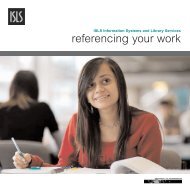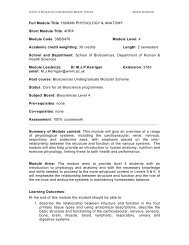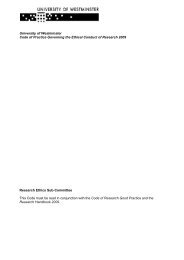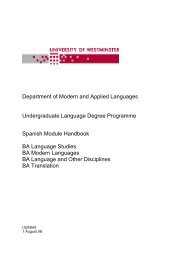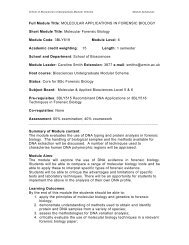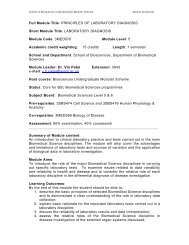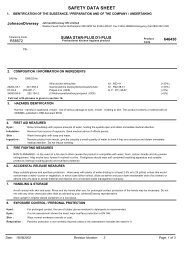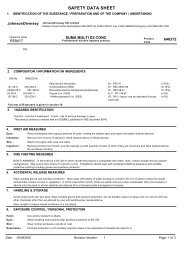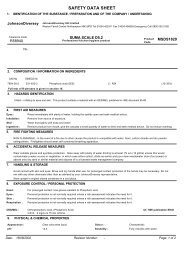CONTENTS 1. Introduction 1.1 Course Outline 1 1.2 Introduction ...
CONTENTS 1. Introduction 1.1 Course Outline 1 1.2 Introduction ...
CONTENTS 1. Introduction 1.1 Course Outline 1 1.2 Introduction ...
You also want an ePaper? Increase the reach of your titles
YUMPU automatically turns print PDFs into web optimized ePapers that Google loves.
Do you appreciate both halves of your brain and what they do<br />
The left side functions in a ‘linear’ way, is very logical and likes to express itself verbally as in<br />
solving maths problems or in preparing and argument for discussion. The right side tends to take<br />
much more of a whole or emotional view of things, and can help us project images for creative<br />
expression of our feelings and emotions. Some of us have a bias toward the left or right of our<br />
brains but we all have a high potential for either.<br />
Do you tend to resent or deride those who appear more successful at study than you<br />
are<br />
It is a very common and human failing to react adversely to the achievements of others. In fact<br />
very often those we deride may simply be better able to use their brains and may not necessarily<br />
possess brains any better in themselves. If we habitually deride others success we risk telling our<br />
own brains not to bother, as we do not wish to be like that. It is much better for our own<br />
learning and development to try and see what habits of study lead to success and try to act<br />
similarly. It is commonly found that the intense study that precedes examinations not only<br />
enhances our comprehension but also our enjoyment of the subject. Try to establish habits of<br />
regular study early in the academic year, it will lighten your load at times of stress and establish a<br />
firm foundation for success based on enjoyment of the subject.<br />
Do you learn more effectively with the ear or the eye<br />
Some people remember a lot of what is said in class, or on television, the radio or talks they have<br />
heard. Students who like to learn by listening sometimes record general facts in their subject on<br />
a tape recorder to help later study. Sometimes they record the lectures they attend, this is<br />
usually entirely acceptable. Other people learn best by the eye; they can pick up a lot from a<br />
diagram very effectively, and benefit especially from written notes. We all have the capacity for<br />
both types of memory and can improve our skill by making use of images, i.e. pictures and<br />
diagrams to help reinforce learning. Your lecturers will often make use of both channels to help<br />
you to learn. Reading alone is unlikely to be as successful as the lecture followed promptly by<br />
backup reading to reinforce and expand the material covered. You will often be given hand-out<br />
material, text and / or diagrams, to assist your study; please use them thoroughly and actively –<br />
not just by passive acceptance.<br />
How good are you at taking notes<br />
Techniques of note taking from lectures or textbooks have to be thought about and worked on.<br />
To be most effective you MUST MAKE THE NOTES YOURSELF, not just copy them (why do you<br />
think this is).<br />
Notes can echo the work of the two sides of the brain. Those in a formal pattern have neat<br />
sentences, all in lines. They may use KEY WORDS – that is words which trigger off other<br />
thoughts, or unlock meanings and memories. Such formal notes can be useful but experts<br />
suggest we should explore another kind of note-making. Flow-diagrams or mind maps depend<br />
more upon the total pattern and call for imagination and originality. They use key words and<br />
images, colour, mnemonics and arrows to show links and associations. The flow pattern may<br />
better represent the way our minds really work; such note schemes are more flexible, visually<br />
and easily remembered. The more interest we take in them, the more use they are likely to be.<br />
They can sometimes be quick to produce, but should not be untidy; the themes need to be clear<br />
and the words are better printed than scrawled.<br />
Do you think you have a bad memory<br />
It is commonly true that people with good memories have, in effect, unconsciously developed<br />
special tricks to help things to stick. Some such techniques, called MNEMONICS, use rhymes or<br />
associations of words to assist the memory (e.g. Richard Of York Gave Battle In Vain to remind<br />
us of the hues of the rainbow identified by Newton as: red, orange, yellow, green, blue, indigo,<br />
violet). Apparently the more silly or amusing the process used to help the memory, the more<br />
information is likely to be retained. Your lecturers may help you by establishing such silly links<br />
from time to time in class. Have you ever tried to devise such a process for yourself If not, try<br />
it out!<br />
DPI_Hbook 27 ©University of Westminster




